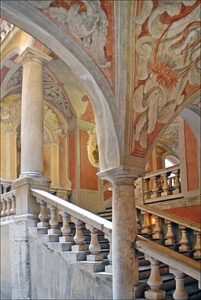Palais Lascaris Museum in Old Nice
 The Palais Lascaris Museum is in three parts: The temporary exhibit, the curious collection of ancient musical instruments (the 2nd largest collection in France), and the opulently restored rooms with furniture and artifacts from the medieval age.
The Palais Lascaris Museum is in three parts: The temporary exhibit, the curious collection of ancient musical instruments (the 2nd largest collection in France), and the opulently restored rooms with furniture and artifacts from the medieval age.
Since I live in Old Nice, I really love visiting the Palais Lascaris because it shows what Vieux Nice used to be like at its origin. My apartment has the same architecture, windows, ceilings, and those amazing carved doors, but since they have been painted over a hundred times, it feeds my imagination to come to this little museum and see what these rooms used to look like in their glory days.
How to get there: Take the tramway to ‘Cathédrale’, then take the street on either side of the tram stop down into the Old Town until you get to the Cathedral at Place Rossetti. Now walk up toward the Chateau Hill, turn left on the second street, and you will see the museum on your left, at 15 rue Droite.
Hours: 10am to 6pm; closed Tuesdays, May 1, Easter, Christmas and Jan. 1.
Tickets: 5€ for adults, or you can get the 4-day all museum pass for 15€ which gives you access to all 10 municipal museums in Nice.
The museum is free for children under 18, students of any age with student ID, locals with the blue Pass Musée, or with the French Riviera Pass.
The Story of Palais Lascaris
 This baroque-style ‘palace’ was built in the early 1600’s for the richest and most powerful family in town, the Vintimille-Lascaris family. Check out the grand staircase, the arches, the unusual carved doors and special hinges (automatic door-closers!), the fresques, and the ingenious medieval air-conditioning system. There are around 20 other ‘palais’ in Old Nice, all with similar architectural elements… if you are renting an apartment in the old town you might even be staying in one and will recognize some of the features!
This baroque-style ‘palace’ was built in the early 1600’s for the richest and most powerful family in town, the Vintimille-Lascaris family. Check out the grand staircase, the arches, the unusual carved doors and special hinges (automatic door-closers!), the fresques, and the ingenious medieval air-conditioning system. There are around 20 other ‘palais’ in Old Nice, all with similar architectural elements… if you are renting an apartment in the old town you might even be staying in one and will recognize some of the features!
Interesting side note: out the back windows you will see rue Benoit Bunico, which was the gated street of Nice’s medieval Jewish ghetto, which was mandated all over Europe at the time. Old Nice was planned and built all at once when the town outgrew the top of the Chateau and rebuilt down below, and in open defiance with this law, the town chose to locate their ‘ghetto’ on the street of the richest family in town, and dug tunnels under the buildings so the inhabitants would have their freedom even when the gates were locked.
The family kept the building until 1801, just after the French Revolution. At that point, the city outside of Old Nice was growing rapidly while the old town was sliding into squalor, and by the beginning of the 20th century Old Nice had metamorphosed into a veritable slum: all these formerly fancy digs were occupied by multiple poor families, usually having only one shared sink and toilet for all families on each floor. Even up through the 1960’s, apartments in Old Nice didn’t have refrigerators, the streets were full of garbage and rats, and kids routinely peed out the windows on to the passersby, earning Old Nice the nickname ‘babazouk‘ or monster’s lair. Despite its lofty origins, this house was no different, and even after it was acquired by the city in the 40’s, it was still inhabited by squatters until the restorations commenced in the 1960’s.
See related page on the History of Nice: 21 Fascinating Facts About Nice
- Back up to main History and Science Museums page
Photo Credits: Stairway by Dalbera, licensed under Creative Commons. Doorway by Best of Nice,
